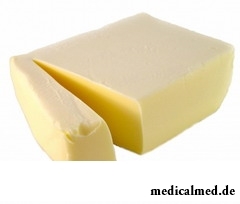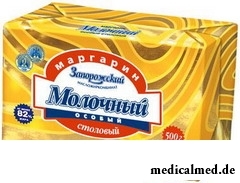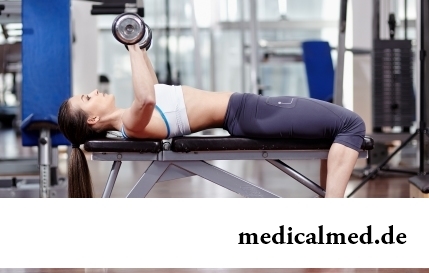





Margarine
Margarine – the cheap substitute of natural butter similar to it on chemical composition, a consistence, a smell and taste.
Margarine was created in France by the chemist Ippolit Mezh-Murye.
was created in France by the chemist Ippolit Mezh-Murye.
Production and structure of margarine
Now make sandwich-type bar and sandwich-type soft margarine, margarine of the improved quality and table margarine. Among consumers sandwich-type margarine of poorly yellow color is most popular.
In production of this foodstuff use auxiliary and main raw materials. As the main raw materials use a fatty basis. Quality of a ready-made product in many respects depends on physical and chemical indicators and rheological characteristics of a basis.
Hardness, temperature of melting and concentration of a solid phase – the most important indicators of properties of margarine. Accumulation of monoacid raznoplavky glycerides gives to this product softness, and high-melting – the increased hardness.
As a fatty basis of margarine most often use various refined sunflower oil without taste and a smell. In the USA as the main raw materials for production of this product serves soy oil, and in Western Europe – rape.
By production of low-calorie margarine widely use palm, coconut and palm vegetable oils. When using these oils this product turns out more plastic. Germany adds to separate grades of margarine pork fat (smalets).
Bar firm margarine for 80% consists of a salomas and for 20% - of liquid fat (most often vegetable oil). Bulk margarine for 40-50% consists of liquid fat.
Milk, butter, salt, sugar, preservatives, emulsifiers, aromatic and flavoring additives (vanillin, cocoa powder, coffee extract) usually are a part of margarine as auxiliary components. Auxiliary components create a water and milk basis of a product.
Salt as a part of margarine impacts it saltish relish, and also reduces spraying at its use for frying of products.
In addition to milk margarine, make now margarine as a part of which there is no milk. However add skvashenny cream, sodium caseinate to some types of such product.
As preservatives by production of margarine in our country it is authorized to use sorbic, lemon and benzoic acids. Holland and Denmark use sorbic acid and sorbate of potassium. Great Britain and the USA use both sorbic and benzoic acid, and their sodium and potassium salts. Enter milk and lemon acids into a water basis of a product for increase in microbiological firmness. Citric acid has synergy effect on preservatives and oxidizers.
For increase in resistance of solid fats to oxidation in structure of margarine include oxidizers – butyl hydroxyanisol and buthylhydroxytoluene in concentration of 0,02%. Usually they are added to mixes with tocopherol, lecithin and citric acid.
Emulsifiers promote moisture deduction, and also have the anti-spraying properties and provide firmness of this product at storage.
Now make margarine chocolate (brown), pink, yellow and other flowers.
Nutrition value and caloric content of margarine
On caloric content margarine not much more concedes to butter. Caloric content of margarine is equal to 745 kcal on 100 g.
Hundred grams of this product contain 16,5 g of water, 0,5 g of ashes, 3 mg of sincaline, 25 mg of vitamin E, 0,03 mg of B2 vitamin, 0,02 mg of vitamin A, 400 mkg of RR vitamin.
Besides, 7 mkg of phosphorus, 10 mkg of potassium, 187 mg of sodium, 1 mg of magnesium and 11 mg of calcium are a part of margarine.
All useful substances are added to this product artificially.
Advantage of margarine
Energy value of margarine is higher, than at cow oil therefore this product is considered a good source of fats. Besides, it contains a number of microelements and vitamins.
The advantage  of margarine consists in its plant origin. For this reason it does not contain cholesterol. Though sometimes add fats of animal origin for improvement of its tastes to structure of this product.
of margarine consists in its plant origin. For this reason it does not contain cholesterol. Though sometimes add fats of animal origin for improvement of its tastes to structure of this product.
The advantage of margarine directly depends on quality of raw materials from which it is made.
Harm of margarine
In scientific community and the press the question of harm of margarine is quite often discussed.
Trans-isomers of fatty acids (TIZhK) and the remains of various chemicals are a part of a product. For this reason margarine can do considerable harm to the adult, and also a children's organism.
Digestive enzymes of the person cannot process the artificial components which are a part of margarine. For this reason the regular use of TIZhK even in small amounts leads to disbolism, to decrease in immunity, and also increases risk of development of a diabetes mellitus, cardiovascular and oncological diseases. Besides, trans-fats worsen quality of breast milk and lead to the birth of babies with an insufficient weight.
At men the regular and long use of margarine leads to sperm deterioration, and also reduces production of testosterone and increases risk of development of infertility.
Storage conditions
Margarine should be stored in the refrigerator at a temperature from 0 to 4 °C – one and a half months, at a temperature from-10 to -20 °C – about two months. The product period of storage also depends on a type of its packaging.
The well-known drug "Viagra" was initially developed for treatment of an arterial hypertension.

It is known that the person for 80% consists of water which participates in all processes of an organism. The person loses liquid daily – in...
Section: Articles about health
Zone hypostases under eyes - very widespread problem giving to people is a lot of inconvenience. Hypodermic fabric in these parts has very loose structure and almost does not contain collagenic fibers. Besides, the skin covering подглазья constantly is exposed...
Section: Articles about health
Use of medicinal plants in therapy is urgent today, more than ever. The drugs made of curative herbs cannot replace completely modern synthetic drugs, but their use becomes frequent serious help in simplification of a course of many illnesses and improvement of quality of life of chronic patients....
Section: Articles about health
The main role in development of a peptic ulcer of a stomach and duodenum the bacterium Helikobakter plays pilor. Activity and Wuxi...
Section: Articles about health
Feeding by a breast - the integral part of ideal motherhood allowing to come into contact with the kid and to create to it healthy immunity since early years. Nevertheless, this important process in life of mother and child can be saddened laktostazy − by a delay of milts...
Section: Articles about health
Summer in the heat. Many are going to spend vacation abroad. Travelers the tender seas, rest on beaches wait, for sightseeing, campaigns on natural and cultural reserves. But, unfortunately, on vacation also problems with health can wait for us. On a foreign trip it is possible to face also diseases which not only will spoil long-awaited issue, but also will force to be treated within long months after its termination. To be insured completely from troubles of it a sort...
Section: Articles about health
Residents of big cities quite often have a disease which is known as the syndrome of chronic fatigue (SCF) today. This illness...
Section: Articles about health
Each person has easy indispositions which he transfers "standing", trying not to ask for medical care. Arguments at the same time are adduced same: "it is a trifle, itself will pass", "I have too many important issues", "there are no wish to spend time on...
Section: Articles about health
The saying "the rich do not know how the other half lives" is known to all. In a broad sense it is that we can not always understand the person whose features of a state are unknown to us. If with physiological characters of diseases the situation is more or less clearly (having noticed them, we realize that to the person nezdorovitsya), then with symptoms of the illnesses affecting the mental sphere everything is much more difficult. Not absolutely usual behavior is quite often perceived surrounding as a ridiculous eccentricity, or that much ху...
Section: Articles about health
Popular joke that there are no healthy people, and is nedoobsledovanny, most of us considers an honest truth, and put that...
Section: Articles about health
Small appetite at the child – the complaint which pediatricians should hear practically from each mother. Most often it is carried to the category of children's whims, however the refusal of food in certain cases can be to alarming symptoms therefore it cannot be ignored....
Section: Articles about health
Stroke (acute disorder of cerebral circulation) – one of the most widespread neurologic diseases. Annually in the world more than 6 million people die of this illness. From the survived patients about 80% become disabled people, and nearly a third from them needs afterwards permanent care. In fact, the stroke creates a situation at which a part of cells of a brain loses blood access, loses an opportunity to receive oxygen and nutrients, and perishes. As a result of a razviv...
Section: Articles about health
Venereal diseases in medicine are called the infections which are transmitted preferential sexually, now they are so...
Section: Articles about health
The naturopathy sometimes moves as the new direction of medicine, something like fashionable hobby, and there is nothing farther from the truth. This most ancient direction, the word "naturopathy" is translated as "treatment by the nature", and, no doubt, treatment приро...
Section: Articles about health
The brain of the person is studied not one hundred years, but the quantity of the riddles connected with this body increases rather, than decreases. Perhaps, numerous delusions concerning a structure and functioning of a brain are explained by it, many of which arose long ago, but continue to exist and today. Such we are ready to acquaint readers with the most widespread myths....
Section: Articles about health
The person, as well as all other beings living on our planet feels weather changing. It is normal meteosensitivity, not...
Section: Articles about health
Life of the modern child is extremely active and difficult. Information strain which is experienced by the school student and did not dream pupils of last times. Careful parents, wishing well to the children, will organize a set of additional classes in circles, sports...
Section: Articles about health
Women quite often suffer from complexes concerning the sizes of the bust. Strangely enough, not too modest, and excessively curvy shapes become the reason of sincere discomfort sometimes. Except psychological problems, the big bust sometimes creates also quite notable malfunctions with health: his owner can feel muscular dorsodynias, feeling of constant fatigue and difficulty of breath. Over time excess loading leads to development of diseases позвоночн...
Section: Articles about health
Tick-borne encephalitis – one of the most dangerous viral diseases which causative agents transfer and is given to people by ixodic mites. Эт...
Section: Articles about health
Life of the modern woman is very difficult. Opportunities to realize itself are wide: it not only education and career, but also the most various hobbies from sport before needlework. It is not less important to build private life, paying an attention maximum to children, the husband, parents, e...
Section: Articles about health
High temperature - a frequent symptom of such widespread diseases as a SARS, quinsy, pneumonia, etc. To reduce heat, having facilitated a condition of the patient, doctors recommend to accept antipyretics, however their use is not always possible. Too frequent use of these drugs can lead to allergic reactions, and also overdose, causing poisoning. It happens also that there are no antipyretics simply in the house. In these situations it is pertinent to use it...
Section: Articles about health
Radiological methods of a research are applied in medicine more than hundred years, and thanks to them millions of lives were saved. In m...
Section: Articles about health
Diapers for adults – individual one-time means of hygiene which in some situations is irreplaceable and from such situations any person is not insured. Though nobody perceives need of their use with enthusiasm, however without it to a sra...
Section: Articles about health
For the city dweller the fitness is the most convenient sport. It is enough to acquire the subscription to the gym to get access to various apparatuses and an opportunity to train under the leadership of the experienced consultant. Many consider fitness the best way of maintenance of physical shape and receiving dynamic loads which the people occupied preferential with brainwork so need. Nevertheless, representations of most of consumers of similar services about специф...
Section: Articles about health
Proofs of efficiency of Mildronate at treatment of coronary heart disease with stenocardia can be found in many publications to...
Section: Articles about health
What woman does not dream of a beautiful and thick hair? While physicians developed difficult schemes on hair transplant, in the industry of hairdresser's art a few years ago there was a sensation – methods of hair extension appeared. It would seem, dreams came true...
Section: Articles about health
Impossibility to conceive the child – a trouble of many Russian families. During quite long time was considered that main "culprits" of troubles such are women. Modern physicians claim that the situation is different: about a half of failures in attempts of reproduction are connected with male infertility....
Section: Articles about health
